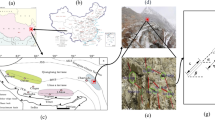Conclusions
The results obtained here can also be used for a plate with a central through crack of the normal rupture type when it is subjected to tension by constant fillers and 1) the material of which the plate is composed, having orthotropic viscoelastic strain properties, can be modeled by a uniform orthotropic viscoelastic material; 2) the prefracture region at the edge of an advancing crack in the plate is small in the height direction; 3) the length of the prefracture region is constant during propagation of the crack.
Similar content being viewed by others
Literature Cited
D. A. Gavrilov and V. A. Markov, “Numerical method of determining the rheological parameters of composites from test results,” Mekh. Kompozit. Mater., No. 4, 605–609 (1986).
A. V. Gorelik, “Study of the fracture of a material reinforced with discrete fibers,” Prikl. Mekh.,13, No. 6, 25–30 (1977).
A. V. Gorelik, “Life of a laminated viscoelastic medium with a crack,”ibid.,16, No. 6, 46–54 (1980).
A. V. Gorelik, “Study of the kinetics of crack growth in laminated viscoelastic materials,” Dokl. Akad. Nauk UkrSSR, Ser. A., No. 7, 34–38 (1980).
V. G. Gromov, “Solution of boundary-value problems of the linear theory of viscoelasticity,” Mekh. Polim., No. 6, 999–1011 (1967).
V. G. Gromov, “Mathematical content of the Volterra principle in a boundary-value problem of viscoelasticity,” Prikl. Mat. Mekh., No. 5, 869–878 (1971).
V. I. Gutsul and A. A. Kaminskii, “Kinetics of the fracture of a viscoelastic plate with two cracks,” Prikl. Mekh.,25, No. 5, 62–69 (1989).
A. A. Kaminskii, D. A. Gavrilov, and S. A. Kekukh, “Method of solving problems of the linear theory of viscoelasticity,”ibid.,23, No. 8, 55–65 (1987).
A. A. Kaminskii, Fracture Mechanics of Viscoelastic Bodies [in Russian], Naukova Dumka, Kiev (1980).
S. A. Kekukh, “Method of expanding functions of integral operators,” Transactions of the 11th Conference of Young Scientists, Part 1, Institute of Mechanics of the Ukrainian Academy of Sciences, Kiev (1986), pp. 92–97.
V. A. Markov, Subcritical Crack Growth in Polymer Composites during Long Static Loading: Author's Abstract of Engineering Sciences Candidate Dissertation, Kiev (1987).
V. V. Panasyuk, Limiting Equilibrium of Brittle Bodies with Cracks [in Russian], Naukova Dumka, Kiev (1968).
Yu. N. Rabotnov, Elements of Hereditary Solid Mechanics [in Russian], Nauka, Moscow (1977).
R. A. Schapery, “A method of viscoelastic stress analysis using elastic solution,” J. Franklin Inst., No. 4, 268–289 (1965).
Additional information
Institute of Mechanics, Academy of Sciences of the Ukraine, Kiev. Translated from Prikladnaya Mekhanika, Vol. 27, No. 11, pp. 77–84, November, 1991.
Rights and permissions
About this article
Cite this article
Kaminskii, A.A., Kekukh, S.A. Delayed fracture of a plate made of an orthotropic viscoelastic composite with a central crack under a constant load. Soviet Applied Mechanics 27, 1104–1111 (1991). https://doi.org/10.1007/BF00887868
Received:
Issue Date:
DOI: https://doi.org/10.1007/BF00887868




